Popups have become a pivotal tool in digital marketing, offering a dynamic way to communicate with website visitors. Often misunderstood as merely intrusive, when designed thoughtfully, popups can significantly enhance user engagement and conversion rates.
Popups, typically a form of overlay that appears over webpage content, serve various purposes ranging from subscriber sign-ups to announcing special offers. The core idea is to capture attention and deliver a targeted message at the right moment.
Effective popups direct user attention to where it matters most, seamlessly integrating into the overall website experience.
Planning Your Popup Campaign

Strategic planning is crucial for successful popup campaigns. By understanding the audience and setting precise objectives, popups can be tailored to meet specific marketing goals without disrupting the user experience.
Identifying Your Target Audience
The first step in crafting an effective popup strategy is understanding who frequents your blog. This involves analyzing visitor data to grasp their interests, demographics, and behavior on your site.
Understanding who reads your blog: Utilize analytics tools to segment your audience based on factors like age, location, and browsing behavior. This segmentation helps in creating more personalized and relevant popup content.
Tailoring popups to audience preferences: The content and design of your popups should resonate with the interests and expectations of your audience. For example, a tech blog's audience might appreciate a signup form for the latest gadget reviews, whereas a fashion blog's visitors might be more enticed by a popup announcing a giveaway or a discount on fashion ebooks.
Setting Clear Objectives for Popups
Defining what you aim to achieve with your popups helps in designing them more effectively and measuring their success.
Goals: Common goals include increasing email subscriptions, promoting specific content, or encouraging social sharing. Each goal requires a different approach in terms of popup design and content.
How objectives shape popup design and content: If the goal is to increase subscriptions, the popup should have a simple form and a compelling call-to-action (CTA). For content promotion, it might showcase popular posts or recent updates with links that draw readers deeper into your blog.
Designing Effective Popups

The design and content of your popups play a crucial role in their effectiveness. A well-designed popup not only catches the eye but also conveys its message succinctly and persuasively, prompting immediate action from the user.
Choosing the Right Type of Popup
Selecting the appropriate type of popup based on your blog's layout and user behavior is essential for minimizing disruption and maximizing engagement.
Lightbox Popups: These are center-screen overlays that dim the background content, focusing the user's attention solely on the popup. Ideal for important announcements or sign-up forms.
Sidebar Popups: These appear at the side of the page, less intrusive, suitable for blogs where readers spend time reading long articles.
Slide-in Popups: They slide in from the side or bottom of the page as the user scrolls down, a subtle option for engaging users without being too disruptive.
Crafting Compelling Content for Popups
The content within your popups must be engaging and offer clear value to encourage positive action.
Importance of Headlines: The headline is the first thing a user sees; it should be compelling and directly related to the value you’re offering. For instance, "Get Our Free Guide to Doubling Your Reader Engagement" instantly informs the user of the benefit.
Tips for Engaging and Concise Copy: Keep the message brief and to the point. Use bullet points if necessary to outline benefits. Ensure that the call-to-action (CTA) is bold and enticing, prompting the user to take action immediately.
Design Aesthetics That Attract Readers
A visually appealing popup can significantly enhance user engagement and reduce irritation.
Using Colors, Fonts, and Images Effectively: Use colors that complement your blog's design but stand out enough to catch attention. Select fonts that are easy to read and align with your blog’s style. Include relevant images or icons that support the message without overcrowding the space.
Ensuring Mobile Responsiveness: With the increasing prevalence of mobile browsing, ensuring that your popups look good and function well on mobile devices is crucial. This involves responsive design elements that adjust size and layout based on the device being used.
Technical Aspects of Popup Implementation
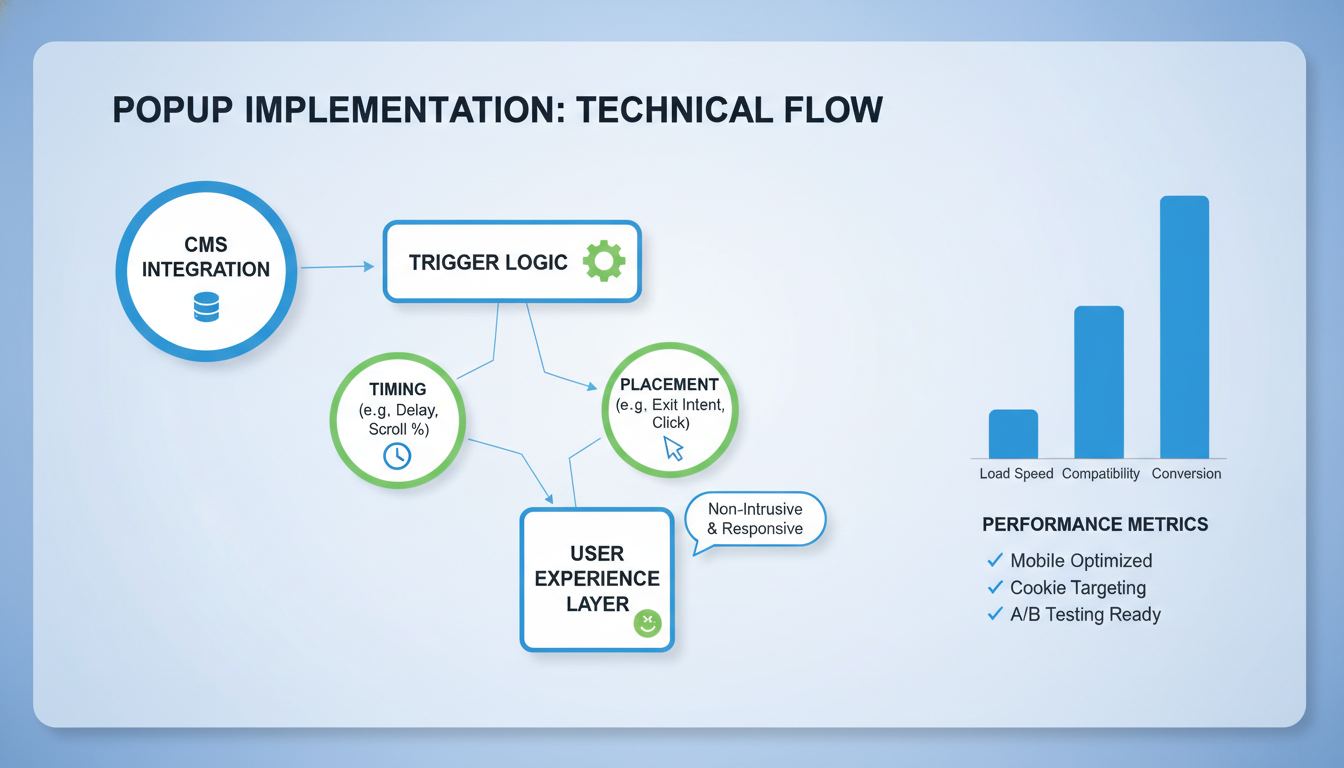
Implementing popups effectively involves more than just design and content. It requires thoughtful consideration of placement, timing, and the technical integration with your content management system (CMS). These aspects are crucial to ensure that the popups function seamlessly and do not detract from the user experience.
Popup Placement and Timing
Choosing where and when your popup appears can significantly impact its effectiveness and the perception of your blog.
Strategic Placement for Maximum Visibility: Placement should be dictated by user behavior and the layout of your blog. For instance, a popup that appears after a user has scrolled 70% of the page shows engagement with the content and might be more welcome than one that appears immediately.
Best Practices for Timing Popups Without Annoying Readers: Timing is critical. Delaying a popup until a user has spent a certain amount of time on a page, or has interacted with your content, can reduce annoyance and increase receptivity.
Using Triggers and Exit-Intent Technology
Utilizing advanced triggering options can enhance the effectiveness of popups by displaying them at opportune moments based on user actions.
How Triggers Work: Triggers can be set based on specific actions such as scrolling to a certain point, spending a specified amount of time on a page, or attempting to leave the page.
Advantages of Exit-Intent Popups: Exit-intent technology detects when a user is about to leave your site and triggers a popup at this critical moment, providing one last chance to engage them. This can be particularly effective for capturing emails or promoting a special offer.
Integrating Popups with Your CMS
Seamless integration of popups into your CMS ensures they operate smoothly without affecting the speed or functionality of your blog.
Plugin Options for Popular CMS Platforms: Many CMS platforms, like WordPress, offer plugins that make integrating and managing popups straightforward. These plugins often come with additional features for customization and analytics.
Custom Coding vs. Using Plugins: For those with specific needs or technical skills, custom coding your popups offers maximum control over functionality and design. However, plugins can provide a more user-friendly and time-efficient solution for most bloggers.
How to Create Popups for Blog Promotion Using Poper
Creating effective popups for blog promotion can significantly boost engagement and conversions. Poper, an AI-powered onsite engagement platform, offers a range of tools and features that make creating and implementing popups straightforward and effective. Here’s a step-by-step guide on how to use Poper to create popups for your blog.
Step 1: Sign Up and Set Up Your Account
Before you can start creating popups, you need to sign up for a Poper account and set up your dashboard.
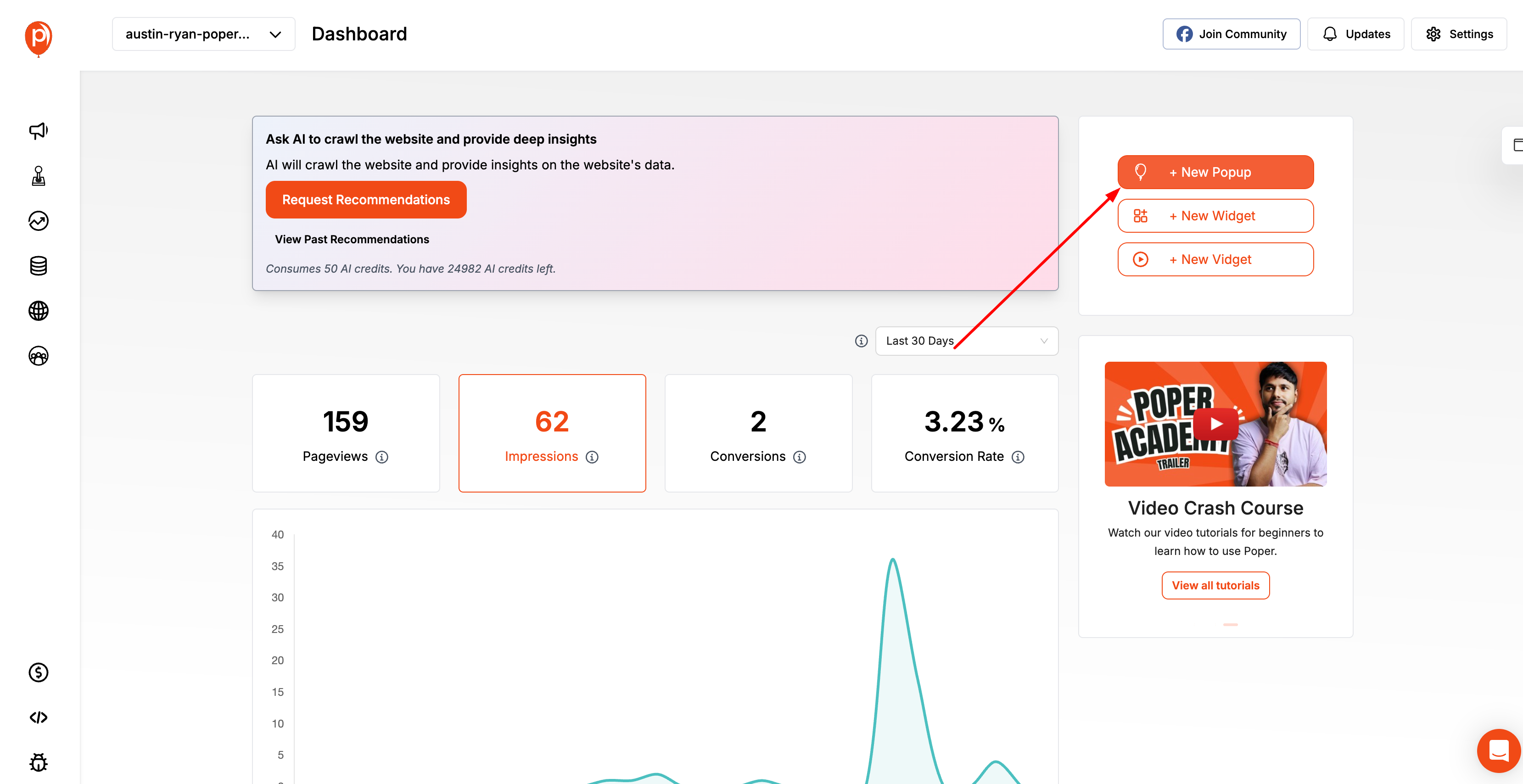
Sign Up: Visit the Poper website and sign up for an account. You’ll need to provide some basic information about your blog and your goals.
Set Up Dashboard: Once your account is created, navigate to your dashboard. This is where you will manage all your popups. Click "New Popup" to start creating.
Step 2: Choose the Type of Popup
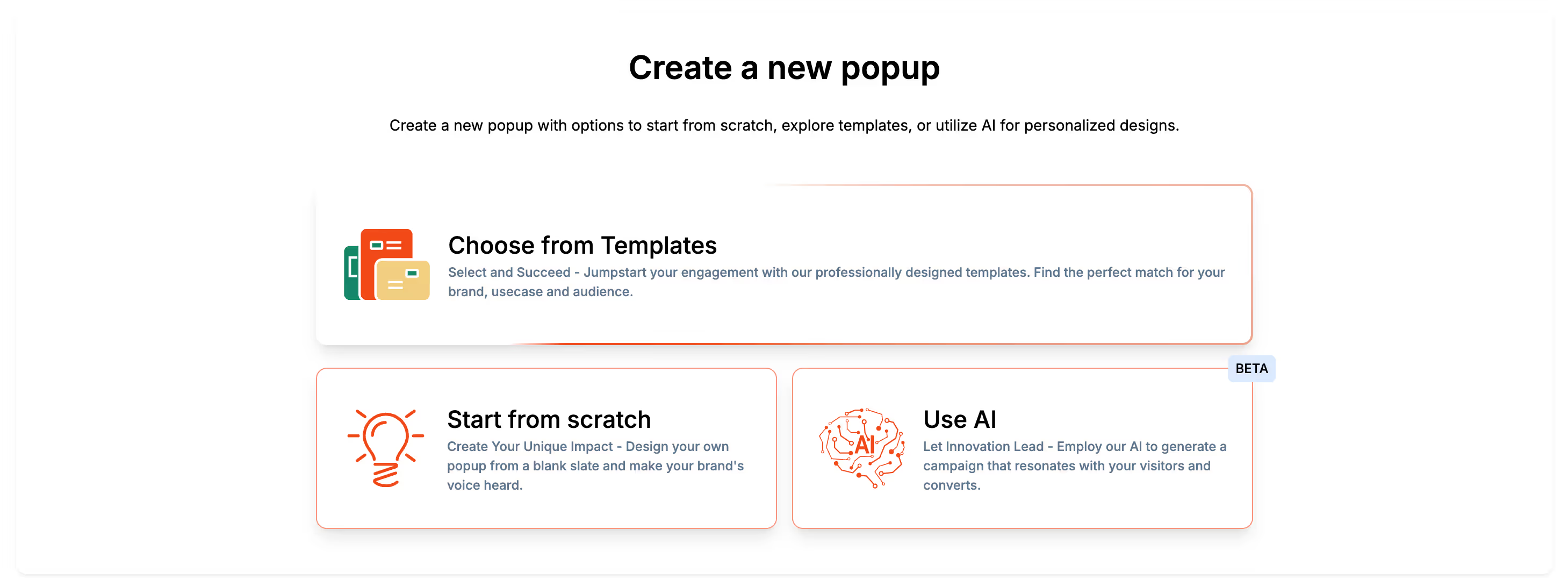
Poper offers various types of popups, each suited for different purposes. Choose the one that aligns with your goal.
Choose from Templates: Poper provides professionally designed templates to jumpstart your engagement. Select a template that fits your brand, use case, and audience.
Start from Scratch: If you prefer, you can design your popup from a blank slate, allowing complete customization to match your brand's voice.
Use AI: Poper's AI feature (currently in beta) generates personalized designs that resonate with your visitors and convert.
Step 3: Customize Your Popup

Customization is key to ensuring your popups align with your blog’s branding and effectively capture your audience's attention.
Design: Use Poper’s drag-and-drop builder to design your popup. Customize colors, fonts, and images to match your blog’s aesthetic. For example, you can create a popup for new blog posts.
Content: Write compelling copy for your popup. Make sure your headline grabs attention, and your call-to-action (CTA) is clear and enticing. For instance, “Subscribe to receive our latest updates!” or “Get your free ebook now!”
Timing and Triggers: Set when and how your popup will appear. Poper allows you to set triggers based on user behavior, such as time on page, scroll depth, or exit intent.
Step 4: Set Display Triggers
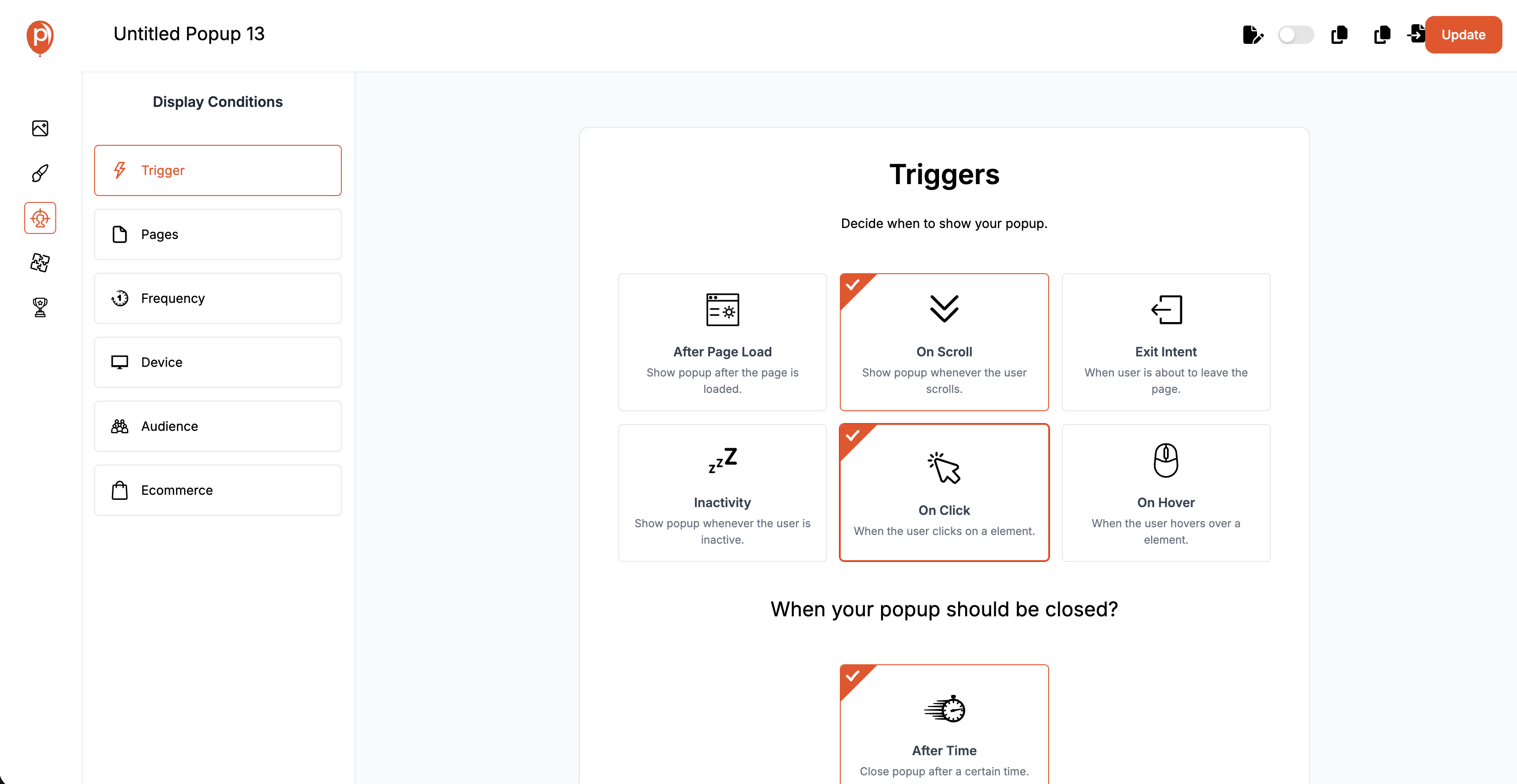
Triggers are crucial for ensuring your popups appear at the right time to engage users without being intrusive.
Display Triggers: Choose from various triggers such as on scroll, inactivity, exit intent, on click, or on hover to display the popup based on user behavior.
Schedule: You can also schedule the popup to show at specific times to align with your campaign goals.
Step 5: Apply AI and Audience Filtering
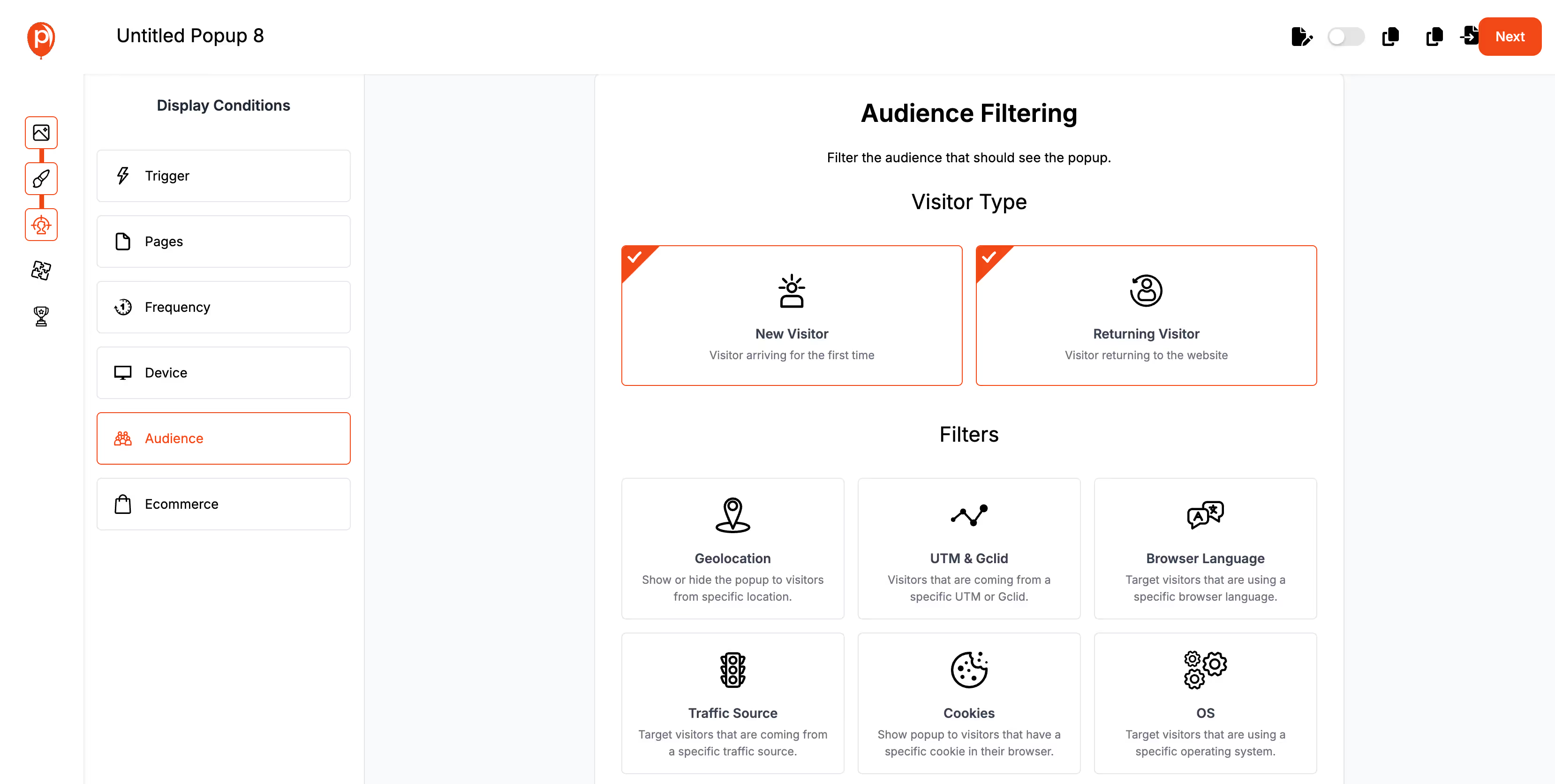
Ensure your popups reach the right audience by leveraging Poper's AI and audience filtering capabilities.
AI & Audience Filtering: Use Poper’s AI to change content dynamically based on visitor type (new or returning), device (desktop or mobile), and other criteria.
Save and Publish: Once everything is set up, click "Save & Publish" to make your popup live.
Step 7: Monitor and Optimize

Monitoring performance and making necessary adjustments is crucial for ongoing success.
Analytics: Use Poper’s built-in analytics to track key metrics such as impressions, click-through rates (CTR), and conversion rates.
A/B Testing: Conduct A/B tests to compare different versions of your popup. Experiment with various headlines, images, and CTAs to see what resonates best with your audience.
Iterate: Based on the data collected, make iterative improvements to your popup.
Create engaging and effective popups for your blog with Poper by customizing design, content, and triggers, and continuously optimizing performance through analytics and A/B testing.
Popup Content Ideas
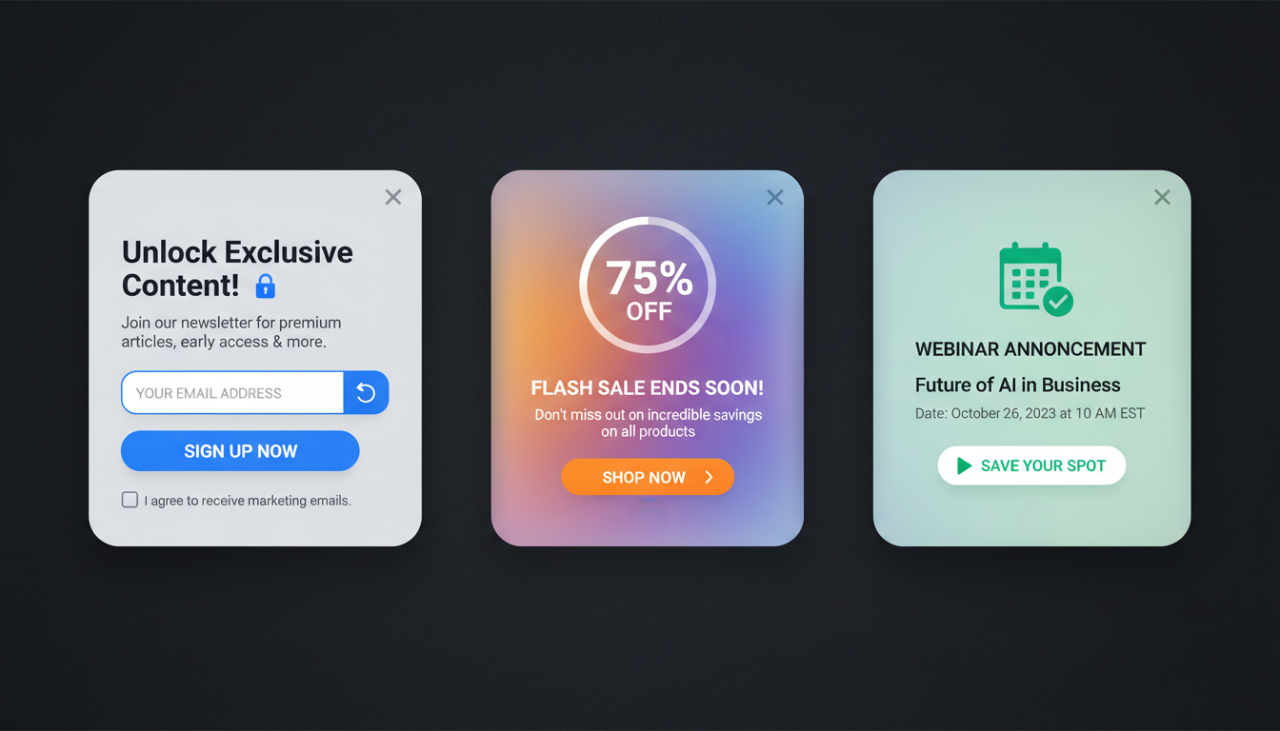
Creating engaging popup content is crucial for capturing interest and driving action. Whether you're looking to boost newsletter sign-ups, promote specific content, or announce events, the right popup can make a significant difference.
Newsletter Sign-Up Popups
Effective newsletter sign-up popups are pivotal for building a subscriber base and enhancing direct engagement with your audience.
Elements of a Successful Signup Popup: A clear, concise message, an attractive offer or lead magnet (like a free ebook or exclusive content), and a straightforward form are key components. Ensure the form is simple, typically asking for just an email address to minimize barriers to signup.
Incentives to Increase Conversion Rates: Offer something of value in return for users' contact information. This could be access to exclusive content, discounts, or entry into a contest. Such incentives significantly enhance the likelihood of conversions.
Content Promotion Popups
Popups can also be an effective tool for promoting specific blog posts, products, or services.
Highlighting Recent or Popular Posts: Use popups to feature snippets from recent or popular blog posts with direct links to the full articles. This not only drives traffic to those posts but also increases the time users spend on your site.
Cross-Promoting Content Across Your Blog: By linking related posts or topics within your popups, you can guide visitors through a more comprehensive journey across your blog, enhancing their overall engagement and satisfaction.
Event and Webinar Announcements
Announcing upcoming events or webinars through popups can help ensure that these important happenings get the attention they deserve.
Using Popups to Boost Event Visibility: A well-timed popup with a compelling call-to-action can significantly increase registration rates for webinars or live events.
Examples of Effective Event Popups: Include key information such as the event date, time, and a brief description. Adding a countdown timer can also create urgency, encouraging users to register sooner rather than later.
Analyzing and Optimizing Popups
Effective popup strategies rely heavily on continuous analysis and optimization. By examining the performance of your popups and refining them based on data, you can significantly improve their effectiveness and your overall engagement rates.
Setting Up Analytics for Popups
Tracking how popups perform on your site is essential to understanding their impact and optimizing them for better results.
Tracking Engagement and Conversion Rates: Use tools like Google Analytics to monitor how often popups are displayed, clicked on, and lead to conversions (such as sign-ups or sales). This data helps identify which popups are effective and which may need adjustments.
Tools and Platforms for Popup Analytics: Many popup plugins and platforms offer built-in analytics that provide insights into user interactions and behaviors. These tools can help refine targeting and timing strategies to increase the effectiveness of your campaigns.
A/B Testing Your Popups
A/B testing is a crucial method for comparing different versions of popups to determine which ones perform best.
How to Conduct A/B Testing: Implement two variants of a popup with one varying element, such as the headline, offer, or design. Display these to different segments of your audience to see which version drives more engagement or conversions.
Analyzing A/B Test Results to Improve Effectiveness: Evaluate the results based on predefined metrics like click-through rate (CTR) and conversion rate. Use these findings to adopt the more successful strategies across your site.
Iterating and Improving Based on Data
Continuous improvement based on analytical data ensures your popups remain relevant and effective over time.
Making Data-Driven Decisions: Use the insights gathered from analytics and A/B testing to make informed decisions about popup modifications. This might include changing the timing, tweaking the content, or even rethinking the popup's purpose.
Case Studies of Successful Popup Optimizations: Analyze case studies and best practices from other successful blogs and websites. Learn what worked for them and how similar strategies can be adapted to your context.
Advanced Strategies and Tools

To elevate your popup strategy beyond basic implementation, leveraging advanced tools and technologies can significantly enhance their relevance and impact. By integrating AI and other sophisticated marketing tools, you can create more personalized and effective popup experiences for your audience.
Leveraging AI for Personalized Popups
Artificial intelligence can dramatically improve the effectiveness of popups by enabling real-time customization and targeting based on user behavior and preferences.
How AI Can Improve Popup Relevance and Timing: AI algorithms analyze user data such as past behavior, engagement patterns, and even the time spent on pages to trigger popups at the most opportune moments.
Tools That Offer AI Capabilities: Many advanced popup solutions incorporate AI to optimize content delivery. For instance, tools like Poper.ai use machine learning to predict the best times and content for popups, enhancing user engagement without being intrusive.
Integrating Popups with Other Marketing Tools
To maximize the impact of your popups, integrating them with other marketing tools can create a cohesive and powerful user experience.
Connecting Popups with Email Marketing Campaigns: Sync popup data with your email marketing platform to tailor follow-up emails based on the actions a user takes. For example, if a user subscribes to a newsletter via a popup, you can automatically enroll them in a relevant email sequence.
Using Popups for Audience Segmentation: By analyzing the data from popup interactions, you can segment your audience more accurately and deliver more targeted content both in future popups and across other marketing channels.
Frequently Asked Questions
What are the most effective types of popups for blogs?
The effectiveness of a popup type largely depends on the blog's content, layout, and audience. However, lightbox popups are generally very effective for capturing attention due to their central positioning and background dimming, which focuses the user's attention. Slide-in popups are less intrusive and can be effective for users who dislike disruptions, as they subtly appear as the user scrolls through content.
How often should popups be displayed to visitors?
Popup frequency should be balanced to avoid overwhelming visitors while still achieving your marketing goals. A good practice is to display a popup based on user engagement signals, such as time spent on the site or interaction with content. Utilizing cookies to remember visitors' preferences can prevent popups from reappearing too frequently, maintaining a positive user experience.
What are the best practices for mobile popups?
For mobile devices, where screen real estate is limited, it's crucial to design popups that are unobtrusive and easy to dismiss. The content should be concise, and the design should be responsive, ensuring that it looks good and functions well on any device. Additionally, since Google penalizes intrusive interstitials on mobile, ensuring compliance with these guidelines will aid in both user experience and SEO.
How can I measure the success of my popup strategy?
Success measurement should focus on specific metrics related to the goals of the popups, such as conversion rates for sign-ups, click-through rates for content promotion, or attendance rates for event announcements. Tools like Google Analytics can track these interactions, providing insights into how well your popups are performing and where improvements can be made.
Are popups really effective in increasing blog engagement and subscriptions?
Yes, when used correctly, popups can significantly enhance blog engagement and increase subscription rates. The key is to offer value through the popups, whether it's exclusive content, discounts, or relevant notifications. By aligning the popup's message and timing with the user's interests and behaviors, you can turn a potentially disruptive tool into a powerful engagement enhancer.
Conclusion
Reflecting on the strategies discussed, it’s clear that popups, when executed thoughtfully, can significantly amplify your blog's reach and engagement. The key lies in aligning them strategically with your blog's content and audience needs, ensuring they deliver value without compromising the user experience.
Summing Up Key Takeaways
Effective Popup Integration: Ensure that your popups are not just seen but are also relevant and timely. The integration of popups should feel natural and beneficial, not forced or intrusive.
Leveraging Technology and Insights: Utilize AI and analytics to refine your popup strategies continually. These technologies help personalize the user experience and optimize engagement based on real-time data.
Adhering to Best Practices and Compliance: Maintain user trust and legal compliance by adhering to data protection regulations and designing popups that respect user preferences and privacy.




